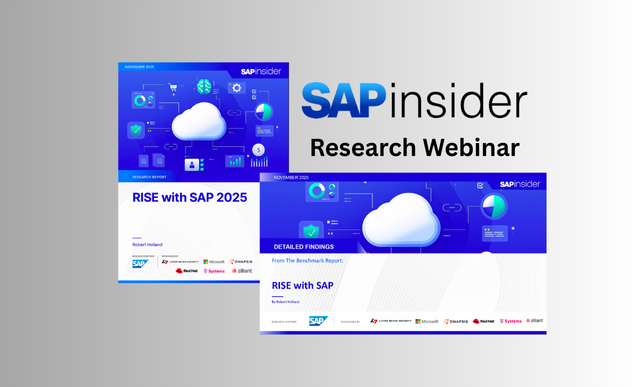Get Started Early with A New Path to RISE with SAP for IBM Power Users
Meet the Experts
Key Takeaways
The move to SAP S/4HANA offers incredible opportunity for innovation for C-Suite executives looking to transform their businesses and embracing agile operating models.
IBM Power Virtual Server gives organizations a like-for-like infrastructure option to migrate from on-premises to cloud while de-risking the entire process.
Keeping the infrastructure for RISE with SAP architecturally consistent on Power Virtual Server helps reduce risk profile and reduces migration time.
The move to SAP S/4HANA offers incredible opportunity for innovation for C-Suite executives looking to transform their businesses and embracing agile operating models. For CIOs, there is no workload more critical that demands focused attention than this transition. ERP systems are the lifeblood of any organization, and ensuring business continuity and reducing complexity are the core considerations when undertaking major technical transformations.
The most business-critical estate requires the smartest business decisions backing it. Every company that uses SAP ERP today is evaluating their eventual move to RISE with SAP. This evaluation is exposing technical debt and inefficiencies that have built up over years of operations, mergers and acquisitions, and expansions. While moving to RISE with SAP brings tremendous benefits to companies, CIOs must approach the journey to cloud ERP strategically—not just to lower capital expenditures and enhance operational efficiency, but also to fundamentally transform their business processes.
Both legacy and heavily customized ERP architectures with multiple point-to-point integrations are a known challenge to migrate. The move to SAP S/4HANA Cloud, combined with embracing SAP’s “Clean Core” methodology makes it easier to build a standardized ERP environment that is efficient to upgrade. And for the thousands of organizations across industries that are currently running their ERP system on IBM Power Systems, either on-premises or in a managed environment, they now have the unique opportunity to accelerate their move to cloud and get even more value from it.
Explore related questions
SAP and IBM recently announced RISE with SAP on IBM Power Virtual Server giving organizations a like-for-like infrastructure option to migrate from on-premises to cloud while de-risking the entire process. According to SAPinsider’s Deployment Approaches to SAP S/4HANA 2024 Report, 72% of organizations anticipate their transition to SAP S/4HANA will take at least 12 months not including building the business case, with the expected deployment timeline increasing year over year.
For IBM Power Systems users, by keeping the infrastructure for RISE with SAP architecturally consistent on Power Virtual Server, moving SAP ERP workloads from Power on-premises to IBM Power Virtual Server helps reduce risk profile and reduces migration time by up to 15-25% as compared to the heterogenous move from Power to x86 environments in other clouds. Some organizations are able to execute the migration in as few as 90 days.
Drawn to the IBM Power platform because of its security, reliability and scalability, enterprises now have an ideal opportunity to bring massive workloads to the cloud in fewer steps with faster ROI and decreased complexity. This infrastructure is purpose-built for running business critical applications like SAP S/4HANA that process sensitive data with utmost reliability and predictability. By accelerating migration and transformation timeline, companies can take advantage of elimination or reduction of maintenance for dual infrastructure, reduced business opportunity costs, and even a drastic reduction in consulting fees. All of these have a demonstrable and measurable impact on not just the business case to justify the transformation, but also on the acceptance and comfort of the end-users who interact with the ERP environment.
Migrating SAP workloads to SaaS environments is significantly more complex than migrating general-purpose workloads. According to IDC, planning for the migration takes 15 months on average and executing the transformation generally takes around 14 months. By starting early and planning carefully, companies that run their SAP workloads on IBM Power infrastructure can speed up the decision-making process and help ensure transformation success.
Here are some steps to begin the decision-making process when considering a move to RISE with SAP.
Align on the business and IT strategy: Understanding the business objectives and aligning on the scope and desired business outcomes will help properly size the project and set expectations within the organization. The IT strategy is to move to a new platform, while the business strategy requires realizing actual benefits from this transformation. These benefits must be tangible to the system’s users and can range from improvements in access, operations and useability. The simultaneous development and implementation of AI-assisted workflows can increase accuracy while decreasing manual user interaction with the system, an added benefit.
Identify key initiatives and the best starting point for the transformation: All successful ERP transformation projects start with a comprehensive analysis of the current environment. It is essential to understand how moving to the cloud will affect business processes, master and transactional data, system configuration, and integration with other business and IT systems. For large enterprises, the most successful transformation projects start with a focused initial system with fewer integration points and minimal customization.
Anticipate the unexpected: Ask early and often about problems or disruptions peer companies have experienced and how to mitigate them. Simultaneously, budget for unexpected costs and disruptions to your timeline. Keep in mind, however, that moving from on-premises to a similar cloud infrastructure can significantly reduce some cost and timing concerns.
Assess long-term infrastructure needs: For growth and innovation, consider how the move to RISE with SAP can impact and support growing generative AI workloads. In addition to ERP and related AI workloads, what surround workloads should be moved to the cloud and which ones can be archived?
Pick the Right Partner to Plan Your Transformation Roadmap: With the help of an experienced Systems Integration partner and the right transformation software and expertise, partners can help align on decisions about the data landscape. They can also help create a roadmap that outlines the steps involved in the transformation and how long it will take.
Getting started on the RISE with SAP journey early will ensure the smoothest path forward. One of the most crucial steps in the process is choosing the right cloud environment to reduce architectural complexity and speed up innovation. In turn, this will help organizations realize value more quickly while empowering business users to make better decisions.









